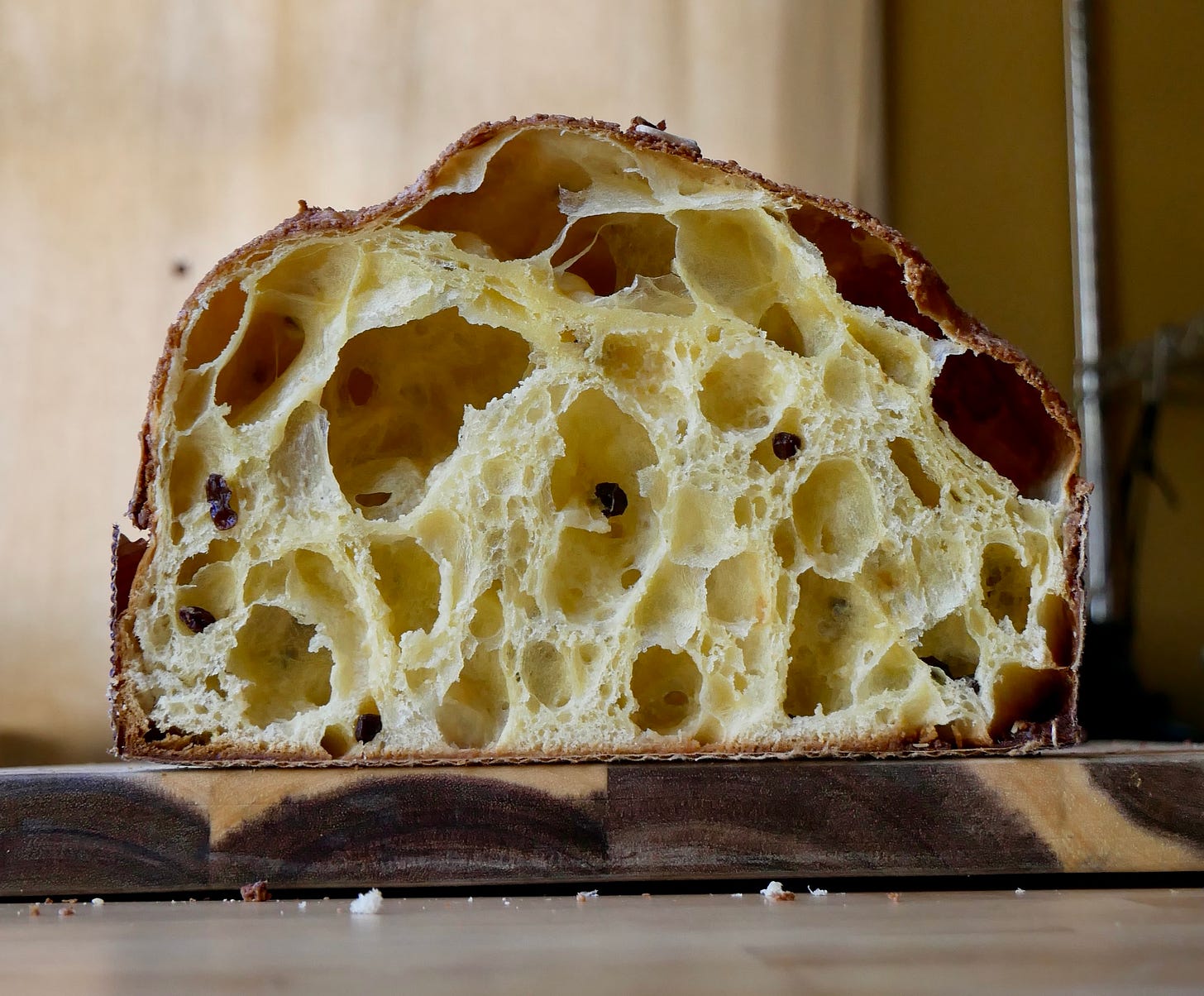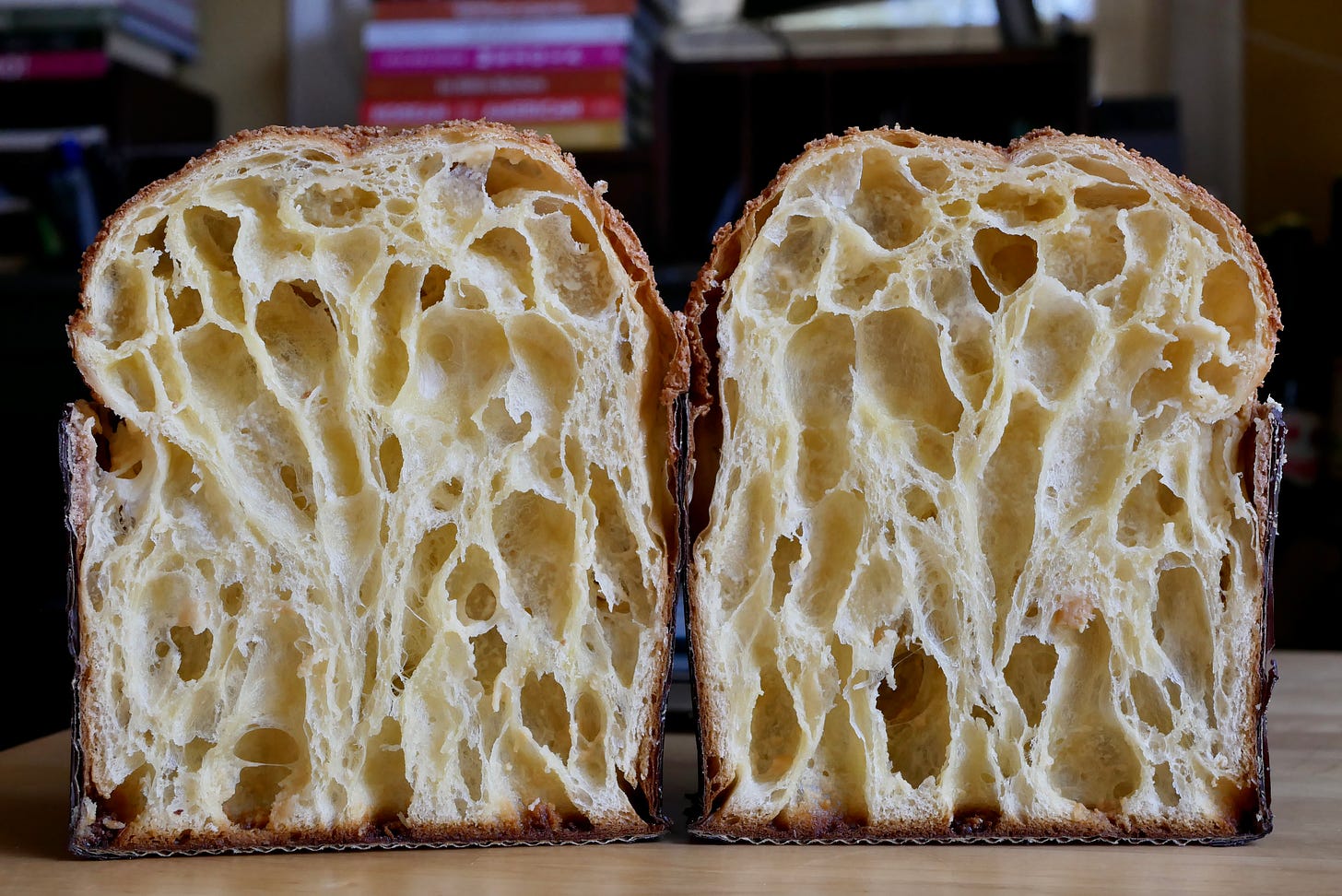How I Learned to Bake Panettone:
I get asked daily what my secret is to baking such beautiful panettone. And the truth is that there is no “secret.” There are no hacks, no magic recipes, no one-word answers that will make you good at baking one of the world’s most difficult baked goods.
The good news is that there is a smart way to learn the craft of panettone baking. I can tell you a little bit about my journey and how I got here. In this short essay, I want to share with you things I wish I knew when I first started this insane project.

It All Starts and Ends With Practice:
You need to get your butt into the kitchen. Only by baking will you understand how the dough behaves during the different stages of the process.
A year into my panettone baking journey, a baker who I respect immensely, told me to focus on experimenting in the kitchen. I honestly wish someone would have said that to me when I first started, mainly because no amount of theory can replace the value of experimenting by making one batch after another after another. This is the only way you will learn how to bake panettone in your own kitchen with its own climate and your specific ingredients.
Reading theory and learning the fundamental “rules” of panettone is an important starting point. But be warned, don’t get stuck in this phase like I did. You need to get your hands dirty and your heart a little broken. Yes, panettone does break hearts everyday. No matter how much information or data you collect about panettone you will never feel completely prepared. Your confidence, knowledge, and expertise will come primarily from baking panettone not reading about it. Having said that there are books and articles that I recommend you read before starting.
3 Panettone Resources I Recommend Reading Before Starting:
Sourdough panettone and viennoiserie edited by Thomas Teffri-Chambelland
The book is organized into three sections: Theory, Practice, Recipes. Carefully read and reread the theory and practice sections of the book to give yourself both the scientific and practical background needed to start baking panettone. In my opinion, this is still the best book on panettone available in English.
Italian Baking, Staff of Life Wordpress by Michael
This is an old school blog and one of the best panettone resources on the internet. It has been around since 2011. I found this blog through the Fresh Loaf forum. Definitely read the comments. They often contain useful information from other panettone bakers who are trying to solve a panettone baking problem. This is a great resource for troubleshooting, incredibly helpful. Michael even built a Universal Method Calculator you can use! Definitely bookmark this page for future reference.
Eight Lessons from My Panettone Saga by yours truly
In this article, I provide a quick overview of the panettone making process along with 8 most important lessons that I learned from my panettone baking journey. I talk about the importance of temperature control and timing, my feelings on pH meters, and much more. My primary goal was to uncover the “hidden curriculum” of panettone in order to make the process a little bit more accessible and save you all some time, money, and emotional labor.

The Value of Working with a Panettone Instructor:
If I had to redo this whole learning panettone from scratch process I would definitely take private lessons. This is something that I believe is a great investment over say a pH meter. Having a teacher can save you a lot of time instead of doing all of your own preliminary research. Instructors are especially helpful with troubleshooting as you have someone you can talk to and problem solve with instead of doing it all on your own. There is very little doubt in my mind that with the help of a panettone instructor you will be able to achieve your panettone goals (at the very least some of them) much faster.
It is especially useful in the beginning when you are inundated with information and there is so much you don’t know. A teacher can help guide you through the process pointing out areas that are most and least relevant for early panettone baking success. They can also tell you which information is essential for you to know at the beginning and which is much less so.
Panettone Instructors I Recommend for Virtual 1:1 Lessons:
To sign up for virtual lessons please message Numa directly on Instagram. I have had many fruitful conversations with Numa on the topic of panettone. Numa is a fountain of knowledge and his classes can help you jump-start your panettone baking. Numa’s panettoni are known for being beautifully aerated and tender.
Mirko offers 1:1 virtual classes and provides his students with a very helpful course packet full of formulas and a detailed step by step guide to his own method to baking panettone, especially the super open crumb Panettone. To learn more you can message Mirko directly: 3294248289. He also said to check out his website.
I understand that not everyone has the money or budget for private lessons. So don’t worry, as in my case, you don’t need to take private lessons to bake delicious panettone. The only thing that might happen is that it might take you a little longer to achieve your panettone goals. Don’t despair, focus on the process, be patient, and remain persistent.

Repetition:
My last piece of advice I want to leave you with today is repetition. So I know it is tempting to jump from one formula to another and from one process to the next process to see what works best for you. Speaking from first hand experience, this approach sadly doesn’t work. In my opinion, it is much better to repeat the same formula over and over and over and over again until you feel comfortable with every step of the panettone making process. Furthermore, never change more than one variable! I know it’s tempting but just don’t. Stick to changing one variable at a time and keeping detailed notes of what you observed from each experiment. Ideally you would repeat the same experiment multiple times but realistically none of us have the funding to be running non-stop experiments in our home kitchens.
Next week I will share one of my favorite recipes that I baked over and over again to improve my panettone baking skills.
RECIPE OF THE WEEK:
Best “Buttermilk” Pancakes
I love pancakes. I’m sitting here holding a pancake with one hand and typing with another, I am 100% telling the truth. One of my life’s goals is to try every type of pancake. I have eaten and made hundreds of pancakes. In the process, I have tried a lot of pancake recipes over the years. When I say this recipe is a keeper, I mean it. The pancakes come out light but spongy.
Almost every culture has their own version(s). What’s your favorite pancake? Ukraine has a rich pancake culture. These buttermilk pancakes are very similar to Oladi, or Ukrainian kefir pancakes. I promise to share our family oladi recipe in the coming weeks.
When I lived in New York City, I kept a list of places with the best pancakes. I shared in a previous newsletter my favorite, Chez Ma Tante pancake recipe. The pancake culture in Austin doesn’t seem to be as lively. I do love pancakes from The Omelettry on Airport Blvd. Although, I do miss their super cute original location on Burnet Road.
I randomly stumbled upon it one day when looking for a quick pancake recipe. This buttermilk recipe comes originally from the Sugar Spun Run blog from Samantha Merritt. I very slightly tweaked the recipe and provided a couple of my own tricks to achieve a perfect buttermilk pancake.
Ingredients:
250 grams King Arthur all-purpose flour
2 teaspoons baking powder
1/2 teaspoon baking soda
40 grams or 3 tablespoons sugar
1/2 teaspoon kosher salt
530 grams buttermilk or kefir
100 grams or 2 large eggs
60 grams unsalted butter melted and slightly cooled
Method:
Sift the flour, baking powder, baking soda, into a medium mixing bowl. Now add sugar and kosher salt. Whisk until everything is combined.
In a separate bowl add the buttermilk and eggs, whisk until fully combined. Slowly add the melted butter to the buttermilk while constantly whisking.
Add the wet ingredients to the dry and gently combine using a spatula (not a whisk) until just combined. Some lumps of flour are ok! VERY IMPORTANT: DO NOT OVERMIX! Let the mixture sit for about minutes until the batter gets super aerated and will have little bubbles on the top. That’s the buttermilk reacting with baking powder/soda.
Heat up a nonstick pan or a cast iron skillet over medium heat with two tablespoons of butter/ghee/clarified butter. Using a measuring cup or basting spoon (my favorite as it’s less likely to deflate the batter) place between 1/4 and 1/2 cup of batter onto the hot pan. Cook on one side for about 2 minutes, or until the sides of the pancakes have set. Flip the pancake and cook for another minute, or until the bottom is lightly browned.
Best served straight from the hot pan. These make a delicious cold snack as well.
You can watch me make the video here.
BAKING NEWS:
I am planning on doing a baking fundraiser the last week of January for Ukraine with my friend Anna Voloshyna. Anna is organizing a fundraiser in the Bay Area to raise money for an ambulance in Ukraine. All proceeds from the bake sale will go towards the ambulance. I am hoping to have some Babkas, cheesecake slices (I got 250 boxes), and maybe cardamom buns available for the bake sale! I will have more details next week.
Thank you to everyone who ordered the Matcha Burnt Basque Cheesecake this past week. I added more spots to the menu! Orders operate on a first-come first-served basis.
COOKBOOKS:
I created a new list of my favorite Baking and Dessert Books. Check it out! Tell me in the comments, what is your favorite baking/dessert cookbook?
SUPPORT MY WORK:
If you would like to support my work by helping me buy ingredients for recipe testing, content development, and newsletter/cookbook writing please consider becoming a paid subscriber.




I can never decide if I love pancakes or waffles more! I do love a yeasted waffle 🥰
I'm such a rookie baker, hence why I think I enjoy Christina Tosi's MOMOFUKU MILK BAR. Crack Pie is to die for!